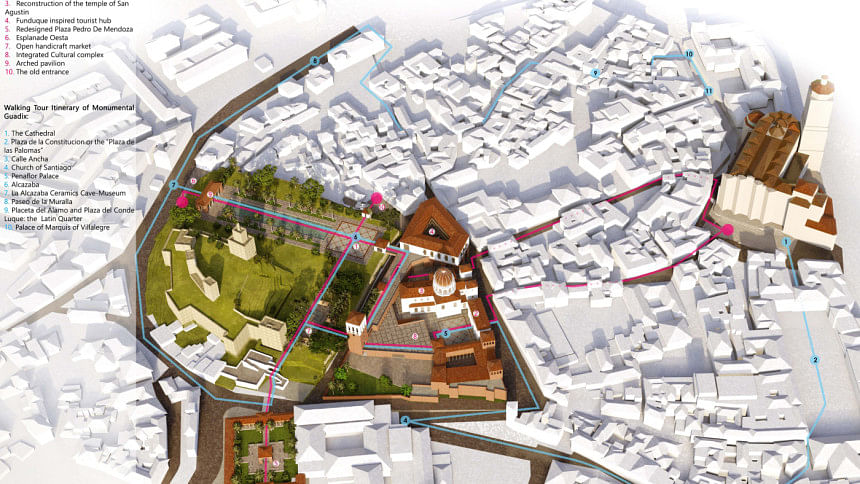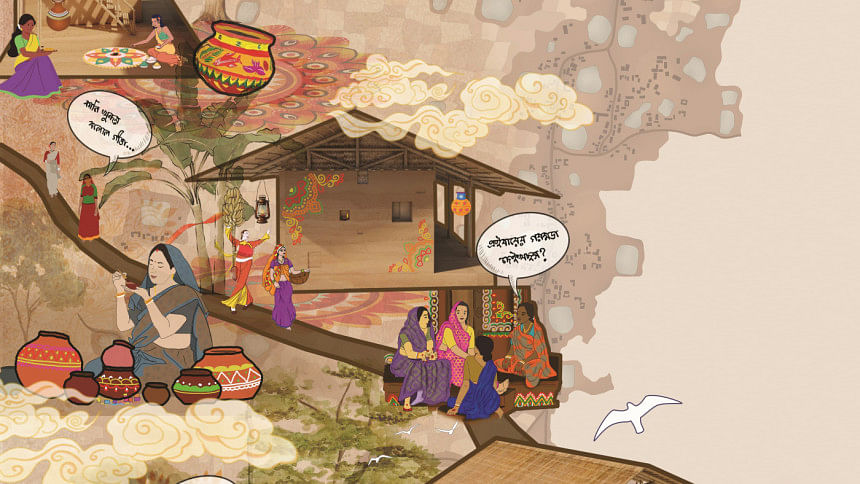As I prepare my thoughts for presentation at the upcoming State Heritage Conference 2025 in Perth, Australia, I find myself reflecting not just on a specific architectural philosophy, but on a journey. It is a journey undertaken over more than a decade within the stimulating intellectual environment of BRAC University in Bangladesh, a journey towards articulating what we now term "New Contextualism." This endeavour, born from the unique socio-cultural and environmental crucible of Bengal, seeks to offer a more nuanced, responsible, and ultimately more humane approach to shaping our built environments. It is with this perspective, deeply embedded in our local experiences yet aspiring towards global relevance, that I wish to share a vision that seeks to intricately weave the rich threads of our past with the pressing necessities and boundless possibilities of the future.
The genesis of New Contextualism lies in a critical appraisal of the dominant architectural paradigms of the recent past. Modernism, with its universalising zeal, often arrived in contexts like ours as an external imposition—its sleek lines and abstract forms frequently disconnected from the lived realities, the climatic imperatives, and the deeply ingrained cultural sensibilities of Bengal. It promised efficiency but sometimes delivered alienation, overlooking the subtle wisdom embedded in vernacular traditions honed over centuries. Postmodernism, reacting against this perceived sterility, swung towards irony and surface quotation, occasionally lapsing into a fragmented pastiche that lacked the deeper resonance and historical continuity we instinctively seek in our surroundings. Neither approach seemed wholly adequate to address the complex tapestry of challenges and opportunities presented by the 21st century, particularly in regions grappling with rapid development alongside profound historical legacies.
New Contextualism emerged not as a prescriptive style, but as a critical framework—a way of thinking that advocates for a design process that is intrinsically forward-looking, yet profoundly anchored in an understanding of the past. It resists the homogenising tendencies of globalisation while simultaneously rejecting a retreat into uncritical nostalgia. Central to its ethos is a commitment to equity and justice, striving for design solutions that are inclusive, acknowledging the diverse needs and aspirations within our communities, and fostering environments where all can thrive.
My personal trajectory towards formalising these ideas was indelibly shaped by experiences both practical and academic. During my early career as an architect-planner for the Barisal City Corporation, I was confronted daily with the imperative to reconcile new interventions with existing urban fabrics, to respect the community's collective memory and future hopes while navigating the practical constraints of a deltaic environment. This wasn't merely about aesthetic compatibility; it was about understanding settlement patterns shaped by water, livelihoods intertwined with the landscape, and social structures reflected in spatial arrangements. How could design honour this intricate web while facilitating necessary progress? This question became a persistent companion.

This practical grounding was later enriched by doctoral research into the early Buddhist architecture of Bengal. Immersing myself in the study of sites like Mahasthangarh, Wari-Bateshwar, and the monasteries that dotted the ancient landscape, I was struck by the profound symbiosis these structures achieved with their context. Their design wasn't arbitrary; it was a sophisticated response to the local climate, harnessing breezes, managing monsoon rains, and utilising locally available materials like terracotta with remarkable ingenuity. Their spatial organisation reflected specific rituals, social hierarchies, and a distinct way of life. This wasn't merely 'building'; it was culture rendered tangible, a testament to a deep, holistic understanding of place. It demonstrated a form of contextualism that was both pragmatic and deeply meaningful, offering invaluable lessons in resilience, resourcefulness, and cultural expression—lessons that resonated strongly with the nascent ideas of New Contextualism. These ancient builders understood, perhaps intuitively, principles we now strive to recapture: designing with nature, not against it, and embedding cultural values within the very fabric of their constructions.
From these diverse streams of influence—the practical challenges of contemporary urban planning in Bangladesh, the deep historical insights from our region's architectural past, and a critical engagement with global architectural discourse—the core tenets of New Contextualism began to crystallise. These are not rigid dogmas, but guiding principles for a more thoughtful and responsible design process:
Forward-Thinking Design Anchored in Prediction
Architecture, by its very nature, shapes the future. The buildings we conceive today will stand for decades, if not centuries. Therefore, design cannot merely react to the present; it must anticipate the trajectory of societal needs, technological advancements, and environmental shifts. This is not speculative fancy, but a profound responsibility. While emerging tools like Big Data and AI offer unprecedented predictive capabilities, their accuracy is contingent upon the depth of our understanding of historical precedents and current trends. The past provides the essential data set—the underlying patterns—upon which meaningful prediction can be built. We must design for the unfolding future, informed by the lessons of the past.
Historical Grounding as Foundational Knowledge
A deep, critical engagement with history is not an optional academic pursuit for the architect; it is fundamental. History illuminates the evolution of societies, the successes and failures of past built interventions, the enduring cultural values embedded in form and space, and the long-term consequences of design decisions. In Bengal, understanding the hybridisation evident during the Sultanate period—the blending of Islamic typologies with local construction techniques and motifs—or the sophisticated water management systems of ancient settlements provides crucial context for contemporary challenges. Ignoring this historical continuum risks creating rootless environments, repeating past mistakes, and failing to leverage the accumulated wisdom of generations.
Holistic Context Understanding – The Tenfold Matrix
Context, in the New Contextualist framework, transcends the immediate physical site. It encompasses a complex, interwoven matrix of factors. To grasp this complexity, we employ a tenfold overlapping analysis, examining the Social (community structures, demographics, lifestyles), Economic (livelihoods, industries, affordability), Political (governance, patronage, regulations), Historical (layers of development, memory, significance), Ecological (climate, topography, biodiversity, resources), Scientific (material properties, technological possibilities), Geographical (location, connectivity, regional influences), Cultural (traditions, beliefs, aesthetics, rituals), Urban (density, infrastructure, public space), and Architectural (typologies, styles, precedents) dimensions. This comprehensive lens, reminiscent of the multi-layered understanding required to decipher Bengal's own complex cultural evolution, ensures that design interventions are not simplistic or unidimensional, but respond sensitively to the intricate reality of place. It prevents the imposition of predetermined solutions and fosters locally attuned responses. For instance, understanding the 'al'—the raised earthen embankment crucial for agriculture and movement in the delta—informs approaches to infrastructure and settlement design in flood-prone areas, a lesson derived directly from the geographical and historical context.
Balancing the Universal and the Particular – The Art of Hybridization
We live in an interconnected world, and universal knowledge regarding structural principles, material science, and technological innovation is invaluable. New Contextualism embraces this global knowledge but insists on its critical adaptation to the specificities of the local. It rejects the wholesale importation of 'International Styles' just as it rejects parochial isolationism. The goal is a productive hybridization, analogous to the process that shaped Baņgālee culture itself through encounters with Vedic, Buddhist, Jain, Islamic, and European influences. It involves filtering global knowledge through the lens of local climate, materials, craftsmanship, cultural norms, and aesthetic sensibilities. The result should be architecture that is simultaneously contemporary and timeless, globally aware and deeply rooted in its place. The evolution of the Sultanate mosque in Bengal, incorporating elements like the curved cornice derived from bamboo construction, exemplifies this successful synthesis.
Designing for Adaptability and Resilience
Change is inherent to the human and natural condition, perhaps nowhere more so than in dynamic landscapes like the Bengal delta. Buildings and settlements must therefore be designed not as static objects, but as adaptable systems capable of accommodating future changes in use, technology, and environmental conditions. Resilience—the capacity to withstand shocks and stresses (like floods, cyclones, earthquakes, or economic shifts) and to recover or transform positively—must be a core design objective. This often involves learning from vernacular traditions, which frequently embody passive resilience strategies, and integrating this wisdom with contemporary engineering and planning techniques.
Building upon this foundation, our ongoing work at BRAC University has led to the articulation of New Contextualism 2.0. This evolution reflects a heightened urgency regarding global environmental challenges and a more explicit integration of contemporary sustainability frameworks. Key enhanced focus areas include:
Nature-Inspired Design (Biomimicry)
Learning directly from the strategies employed by local ecosystems and organisms to thrive in specific conditions. How do mangroves dissipate wave energy? How do termite mounds achieve passive cooling? Nature offers millennia of R&D for sustainable solutions.
Deep Sustainability Integration
Moving beyond superficial 'greenwashing' to embed sustainability principles throughout the design lifecycle—from material sourcing and energy efficiency to water management and waste reduction—always prioritising locally appropriate solutions.
Alignment with UN Sustainable Development Goals (SDGs)
Explicitly mapping design intentions and outcomes against the global framework of the SDGs, ensuring that architectural interventions contribute tangibly to broader goals of poverty reduction, health and well-being, clean energy, sustainable cities, and climate action.
Enhanced Focus on Proactive Resilience
Designing not just to withstand current hazards but to anticipate and adapt to future climate change impacts, such as sea-level rise and increased storm intensity, which pose existential threats to regions like coastal Bangladesh.
Presenting these ideas at the State Heritage Conference in Perth is particularly significant. Heritage, within the New Contextualist perspective, is not a static relic to be cordoned off or merely replicated. It is a vital, living continuum—a repository of knowledge, identity, and meaning that must actively inform contemporary design. Understanding the historical layers, the cultural narratives, and the embedded wisdom within heritage sites allows us to create interventions that are respectful yet innovative, fostering a sense of continuity rather than rupture. It's about building upon legacy, not just beside it.

Our academic explorations have yielded tangible proposals that illustrate these principles. The redevelopment proposal for Dhaka's historic Chawk Bazar, undertaken as a student design studio project, grappled with the intense complexities of regenerating a centuries-old marketplace pulsating with informal commerce, dense habitation, and irreplaceable heritage structures. Applying New Contextualist principles led to strategies focused on phased interventions, integrating livelihoods, adaptive reuse of historic buildings, and the introduction of contextually sensitive materials and forms, aiming to enhance functionality and safety while preserving the unique, vibrant chaos that defines its identity. Similarly, a conceptual proposal for reclaiming the Al-Cazaba in Almeria, Spain, explored how this philosophy could guide the revitalisation of a historically layered Islamic fortress complex, respecting its profound heritage while integrating contemporary uses and enhancing public accessibility. Again, in the revitalisation of the Alpona Gram, the New Contextualist proposal aimed to transform it into a community-based tourism destination to manage tourism's impact on the existing settlement fabric and benefit the community.
As Bangladesh navigates its path of rapid development, the choices we make regarding our built environment are critical. Unthinking adoption of generic global models risks erasing our unique cultural identity and exacerbating environmental vulnerabilities. Embracing a philosophy like New Contextualism offers a potential pathway towards creating cities and settlements that are not only functional and aesthetically considered but are also deeply resonant with our rich Baņgālee heritage, intelligently responsive to our specific ecological and social context, and robustly equipped to face the challenges of the future. My upcoming presentation in Perth is an opportunity to share these insights, honed in the delta, on a global stage. It is my sincere hope that this engagement will stimulate further dialogue, critical reflection, and ultimately, the wider application of New Contextualism, both within Bangladesh and beyond, contributing to the creation of built environments that are more sustainable, equitable, and deeply meaningful for all.
Dr Mohammad Habib Reza is an architect, architectural historian, and Associate Professor at the School of Architecture and Design, BRAC University, specialising in architectural and urban design history and theory, and heritage management.




Comments